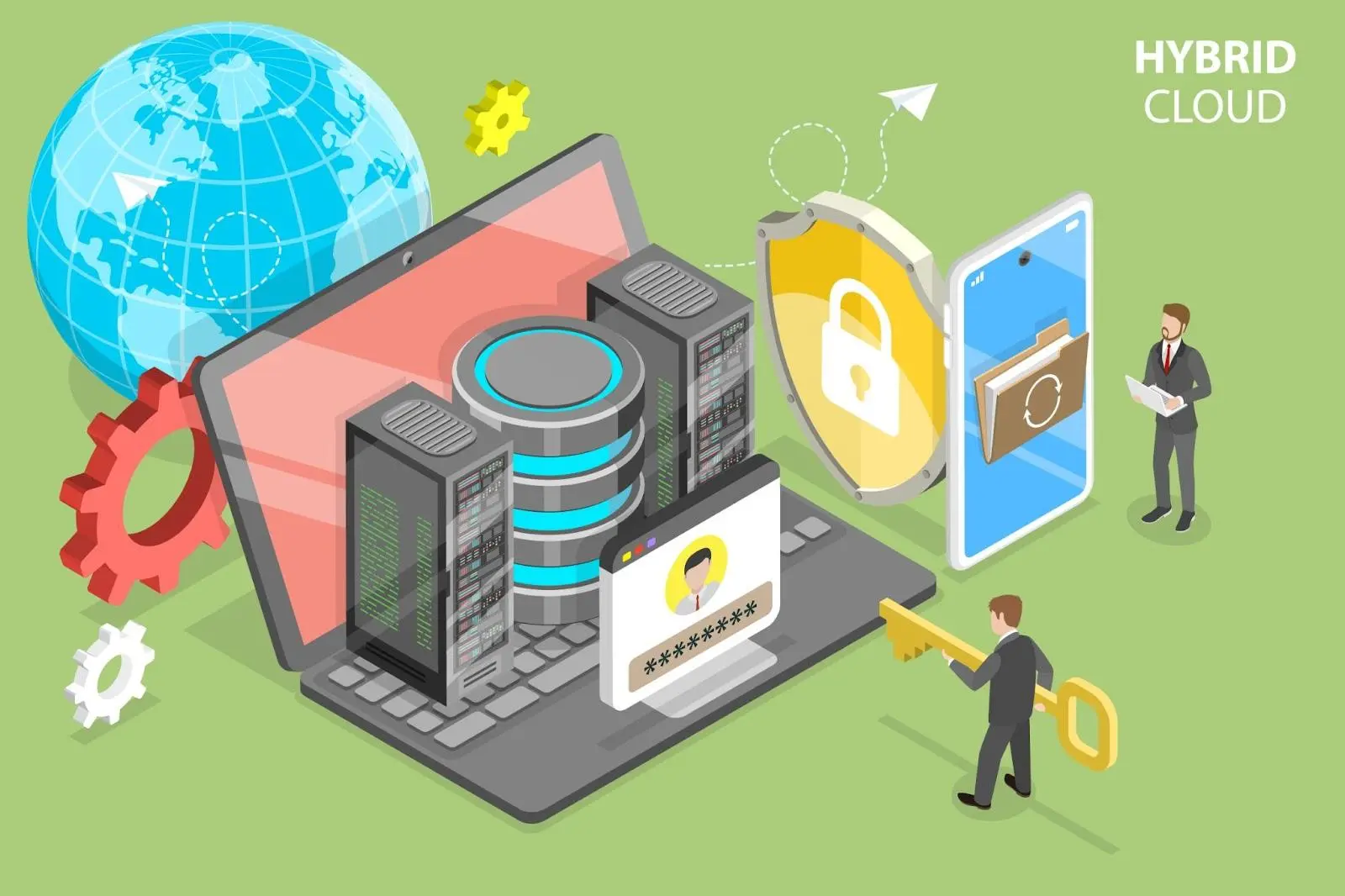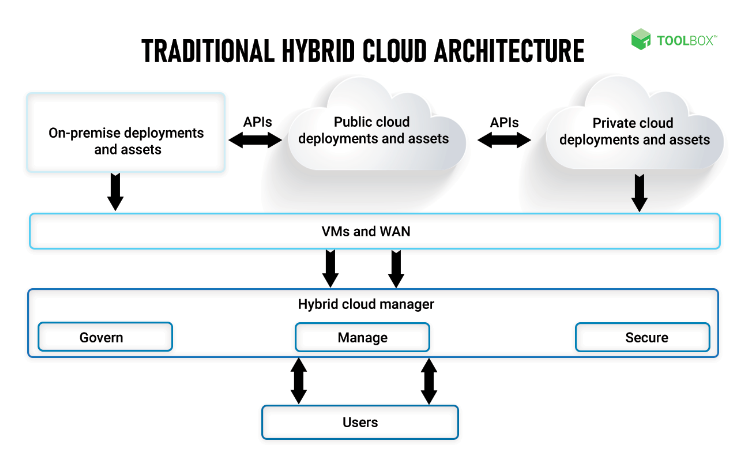
The need to adapt and evolve quickly is a core principle of a digital business. With rapid
technological advancements, businesses today have to look for solutions that provide them with
agility and flexibility while remaining relevant to their core business goals.
One such solution is a hybrid cloud that drives innovation and helps organizations build new
services while empowering them to meet their customer needs better. The article discusses the
hybrid cloud, how it works and how it can benefit businesses.
What is Hybrid Cloud?
A hybrid cloud refers to a single, unified, and flexible distributed computing environment that
integrates public cloud services and on-premise infrastructure or private cloud and provides
management and orchestration across them. It allows organizations to keep their sensitive data
on-premises while taking advantage of the scalability and cost-effectiveness of public cloud
services.
A hybrid cloud provides businesses greater flexibility by helping them move workloads between
cloud solutions and on-premises data centers as needs and costs change. Also, it helps
organizations achieve their business goals more cost-effectively and efficiently than the private
or public cloud alone.
According to a 2020 IBM study, “companies obtain up to 2.5x the value from a hybrid cloud
than a single-cloud, single-vendor approach.”
How does Hybrid Cloud Work?
In a hybrid cloud environment, organizations deploy workloads in private IT environments or
public clouds and move between these workloads as their computing needs or costs change.
The interconnectivity between public and private clouds is made possible using data
visualization and other connected devices and applications, such as VPNs, APIs, and WANs.
The security of a hybrid cloud is achieved using different security solutions, such as network
segmentation, firewalls, and encryption. By connecting your IT environment to a hybrid cloud,
especially if your organization manages multiple resources and data, you get greater control
over data safety, protection, availability, and security of your IT infrastructure and client’s data
applications.
Hybrid Cloud Architecture
The unifying nature of the hybrid cloud architecture makes it more complex than just setting up
a private or public cloud. Data migration across various layers is a crucial part of the overall
model. You need to centralize access controls with unified authentication and authorization
practices in place. Keeping this in mind, establishing a hybrid cloud consists of the following
components:

● Public cloud: A public cloud is usually an Infrastructure-as-a-Service (IaaS) platform,
such as Amazon Web Services, Microsoft Azure, or Google, that owns and manages
computing and storage devices for you.
● Private cloud: Private cloud involves dedicated systems serving only the organization in
question and often are higher in price than public clouds. Hybrid cloud architecture has
an on-premise setup or at least one private cloud.
● Integrators: Integrators can be application programming interfaces (APIs), virtual private
networks (VPNs), or wide area networks (WANs) that connect components for active
communication and provide a setup for upcoming additions.
● Data fabric: It is a software-led approach providing a unified structure that runs on
diverse technologies in a hybrid architecture. These points can be anywhere in the
public or private cloud or on-premise data centres. They facilitate the processing,
movement, storage, and maintenance of data.
● Unified management tools: Since security is critical for any technology architecture,
tools and processes to secure critical assets are important in a hybrid cloud
infrastructure. These include centralized IAM, network segmentation, monitoring,
resource management, and more.
Hybrid Cloud Use Cases
The ability to scale on demand makes the hybrid cloud suitable for many business use cases.
These include.
Digital Transformation
Companies looking to modernize their IT infrastructure by adopting a public cloud may find
hosting entire private data centers challenging due to legacy applications or compliance factors.
A hybrid cloud helps companies to migrate parts of their IT infrastructures to the cloud and
retain some on-premises.
Workload Anomalies
An application running effectively in its existing environment may not continue to do so and
require additional computational power. Hybrid cloud environments adapt to your existing
workload requirements while allowing service to continue smoothly even if requirements
change.
Disaster Recovery
Companies can use a hybrid cloud to replicate on-premises workloads and backup their data in
the cloud. In the event of any disruption or disaster in the data centre, workloads shift over to the
cloud environment and operate appropriately through on-demand cloud resources. However,
consider careful implementation to avoid hybrid cloud backup challenges, such as management
complexity and bandwidth consumption.
Regulatory compliance
Today different regulatory bodies have regulated companies to protect sensitive data. However,
only some of the data is worth putting in a private environment. A hybrid cloud enables your
business to comply with regulations while taking advantage of extended computing power.
Benefits of Hybrid Cloud
Here is a list of a few significant benefits of hybrid cloud environments.
● Greater infrastructure efficiency: By having more control over resources, teams
responsible for the development and IT operations can efficiently optimize spending
across private and public clouds and cloud vendors. Also, the hybrid cloud enables
companies to modernize their applications faster and link cloud services to data
on-premises or on the cloud, creating new opportunities that drive business value.
● Business accelerations: A hybrid cloud environment accelerates business processes,
which means shorter development cycles, accelerated technology and time-to-market,
faster delivery of applications, and integration and collaboration with third parties or
stakeholders to deliver new products and services.
● Increased flexibility: Organizations with a wide range of application requirements and
digital business initiatives can benefit from hybrid cloud, as it provides options to host
applications in traditional setups and the latest cloud technology, speeding up IT
response to changing needs.
● Reduced complexity: With a unified operating model across departments, IT teams can
simplify operations to optimize the mix of capital and operating expenses, reducing
security and operating risks and enhancing operating efficiency while avoiding gaps and
silos.
Unlocking the Potential of Hybrid Cloud with Taikun
While hybrid cloud environments provide several benefits to businesses today, managing them
may be challenging due to incompatibility between legacy applications and new services or
integration complexity. A cloud management tool like Taikun can help you manage your cloud
platform for easy Kubernetes cluster deployment, access management, applications and
catalogs, and much more.


